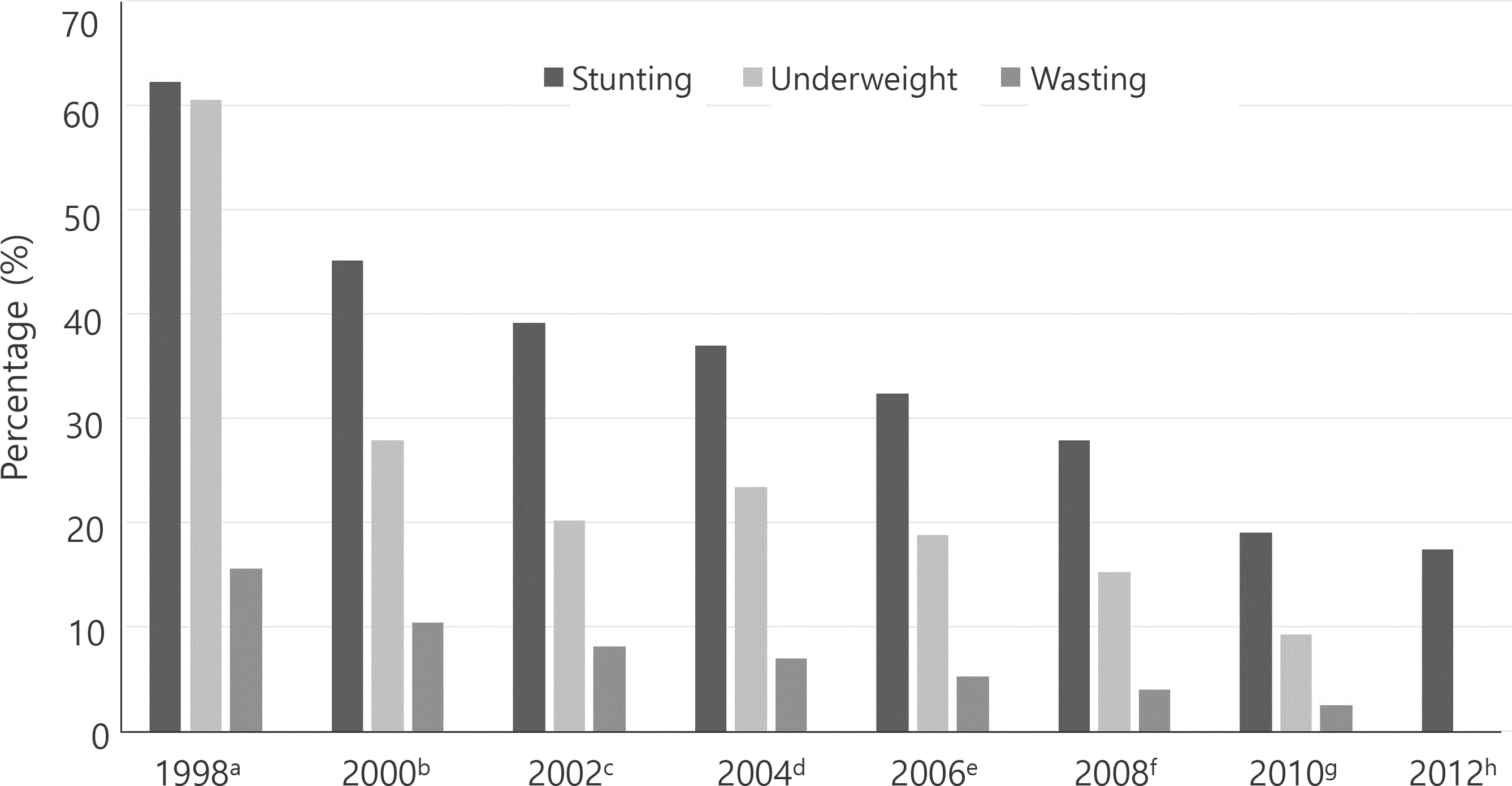J Korean Soc Matern Child Health.
2022 Jul;26(3):140-145. 10.21896/jksmch.2022.26.3.140.
North Korean Children's Health and the Role of Maternal and Child Health Experts
- KMID: 2532470
- DOI: http://doi.org/10.21896/jksmch.2022.26.3.140
Abstract
- According to the World Health Organization (WHO), the health indicators and nutritional status of North Korean children have improved steadily since 2010. However, malnutrition remains a serious condition, with 19.1% of children stunted. in addition, although the nutritional status of North Korean refugee children has gradually improved since they settled in South Korea, a rapid increase in obesity rates has put them under a double burden of malnutrition and obesity. For the health of North Korean children who are at risk because of the recent rapid increase in coronavirus disease 2019 cases in North Korea, maternal and child health experts should work together to request immediate humanitarian assistance from the international community and the South Korean government. Furthermore, it is necessary to develop a maternal and child health program in preparation for the resumption of inter-Korean exchanges and cooperation in the future.
Figure
Reference
-
BBC News. North Korea: more than a million covid cases feared. BBC News [Internet]. 2022 May 16. [cited 2022 May 16] Available from: https://www.bbc.com/news/world-asia-61436270.Central Bureau of Statistics. DPRK 2004 nutrition assessment report of survey results. Pyongyang (North Korea): Central Bureau of Statistics;2005.Central Bureau of Statistics. Nutrition survey of the Democratic People's Republic of Korea. Pyongyang (North Korea): Central Bureau of Statistics;1998.Central Bureau of Statistics. Report of the second multiple indicator cluster survey 2000, DPRK. Pyongyang (North Korea): Central Bureau of Statistics;2000.Chang NS., Kang EY., Lee JM. Anthropometric measurements and dietary patterns of North Korean migrant children in China. J Nutr Health. 2000. 33:324–31.Choi SK., Park SM., Joung HJ. 2010. Still life with less: North Korean young adult defectors in South Korea show con-tinued poor nutrition and physique. Nutr Res Pract. 2010. 4:136–41.
ArticleDe Rooij SR., Bleker LS., Painter RC., Ravelli AC., Roseboom TJ. Lessons learned from 25 Years of Research into Long term Consequences of Prenatal Exposure to the Dutch famine 1944–45: The Dutch famine Birth Cohort. Int J Environ Health Res. 2021. 5:1–15.
ArticleDemocratic People's Republic of Korea. Democratic People's Republic of Korea voluntary national review on the implementation of the 2030 agenda. The United Nations;2021. [cited 2022 May 5] Available from: https://sustainabledevelopment.un.org/content/documents/282482021_VNR_Report_DPRK.pdf.Food and Agriculture Organization. Crop prospects and food situation – quarterly global report No. 1. Rome (Italy): Food and Agriculture Organization;2020.KBS World. N. Korea runs out of polio vaccine for first time. KBS World [Internet]. 2021 Feb 20. [cited 2022 Apr 31]. Available from: https://world.kbs.co.kr/service/news_view.htm?lang=e&Seq_Code=159692.Kim JH., Yun SH., Hwang SS., Shim JO., Chae HW., Lee YJ, et al. The 2017 Korean National Growth Charts for children and adolescents: development, improvement, and prospects. Korean J Pediatr. 2018. 61:135–49.
ArticleKim SY., Choi SW. Double burden of malnutrition and obesity in children and adolescents from North Korean refugee families. PLoS One. 2020. 15:e0241963.
ArticleKim YY. An evaluation of the health status of children from North Korea. Health Nurs. 2005. 17:55–63.Lee IS., Park HR., Kim YS., Park HJ. Physical and psychological health status of North Korean defector children. J Korean Acad Child Health Nurs. 2011. 17:256–63.
ArticleLee SK., Nam SY., Hoffman D. Changes in nutritional status among displaced North Korean children living in South Korea. Ann Hum Biol. 2015. 42:581–4.
ArticleMinistry of Unification. Entry status of North Korean refugees 2022. [cited 2022 Apr 31]. Available from: https://www.unikorea.go.kr/unikorea/business/statistics/.Pak S. The biological standard of living in the two Koreas. Econ Hum Biol. 2004. 2:511–21.
ArticleSchwarzenberg SJ., Georgieff MK. Advocacy for improving nutrition in the first 1000 days to support childhood development and adult health. Pediatrics. 2018. 141:e20173716.
ArticleThe Global Health Observatory. Explore a world of health data, immunization coverage, nutrition [Internet]. Geneva (Switzerland): World Health Organization;2022b. [cited 2022 Jun 5]. Available from: https://www.who.int/data/gho/data/indicators/indicator-details/GHO/bcg-immunization-coverage-among-1-year-olds-(-).The Global Health Observatory. Explore a world of health data, maternal and reproductive health [Internet]. Geneva (Switzerland): World Health Organization;2022a. [cited 2022 Jun 5]. Available from: https://www.who.int/data/gho/data/indicators/indicator-details/GHO/maternal-mortality-ratio- (per-100-000-live-births).UNICEF, Central Bureau of Statistics. DPR Korea multiple indicator cluster survey 2017: survey findings report. Pyongyang (North Korea): Central Bureau of Statistics and UNICEF;2018.UNICEF, Central Bureau of Statistics. DPRK multiple indicator cluster survey 2009: final report. Pyongyang (North Korea): Central Bureau of Statistics;2010.UNICEF, WFP, Central Bureau of Statistics. Report on the DPRK nutrition assessment 2002. Pyongyang (North Korea): Central Bureau of Statistics;2003.UNICEF, WFP, WHO, Central Bureau of Statistics. Democratic People's Republic of Korea final report of the national nutrition survey 2012. Pyongyang (North Korea): Central Bureau of Statistics;2013.Victora CG., Adair L., Fall C., Hallal PC., Martorell R., Richter L, et al. Maternal and child undernutrition: consequences for adult health and human capital. Lancet. 2008. 371:340–57.
ArticleWHO Multicentre Growth Reference Study Group. WHO child growth standards based on length/height, weight and age. Acta Paediatr Suppl. 2006. 450:76–85.World Health Organization. WHO child growth standards and the identification of severe acute malnutrition in infants and children: a joint statement by the World Health Organization and the United Nations children's fund. Geneva (Switzerland): World Health Organization;2009.
- Full Text Links
- Actions
-
Cited
- CITED
-
- Close
- Share
- Similar articles
-
- Effects of e-Health Literacy, Parenting Stress, and Maternal Role Confidence on Children’s Health-Promoting Behaviors in Mothers of Infants and Toddlers
- The Present and Future Status of Maternal and Child Health From the Perspective of Unification Medicine
- Comparison of Maternal and Child Health Statistics between South and North Korea
- Current Status and Future Challenges for Maternal and Child Health in North Korea
- Effect of Oral Health Education on Oral Health Knowledge, Oral Health Behavior and Oral Hygiene Status in Children from North Korea


